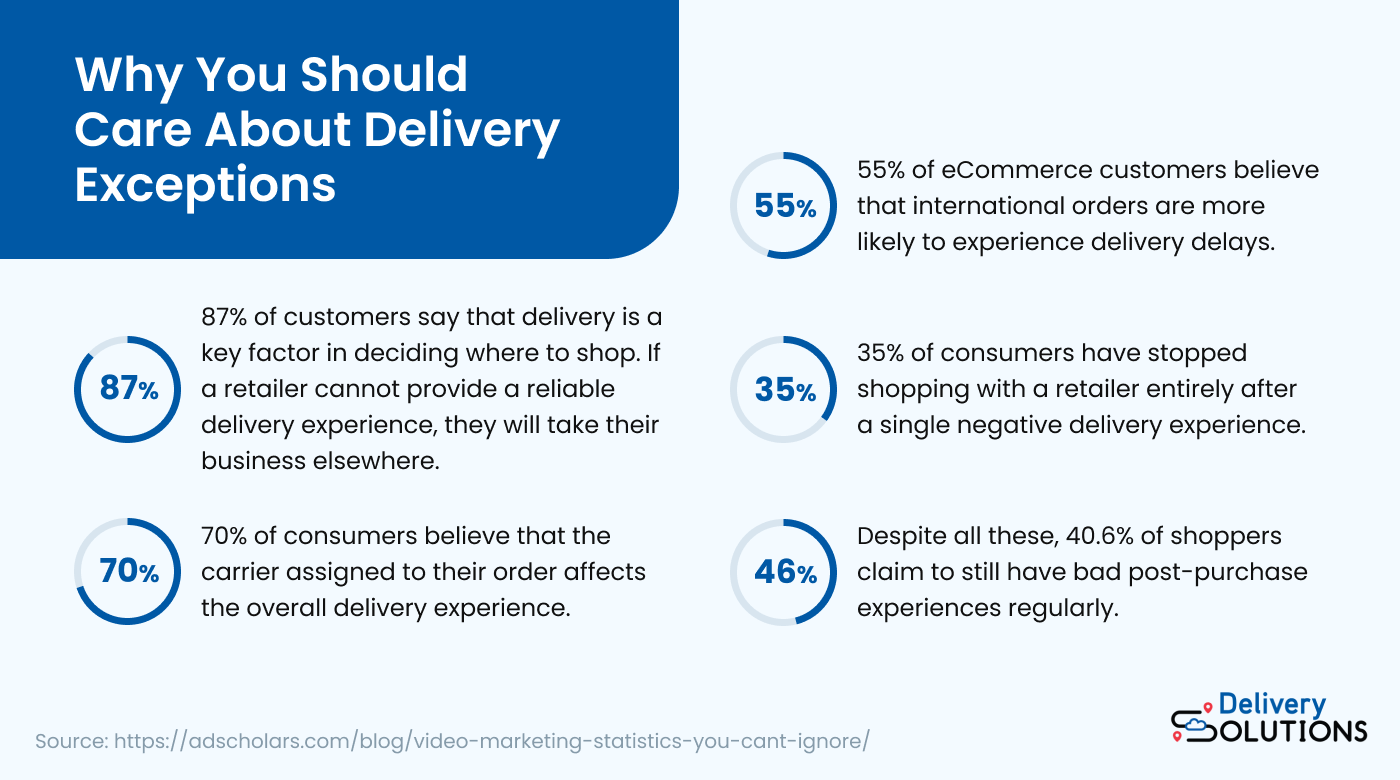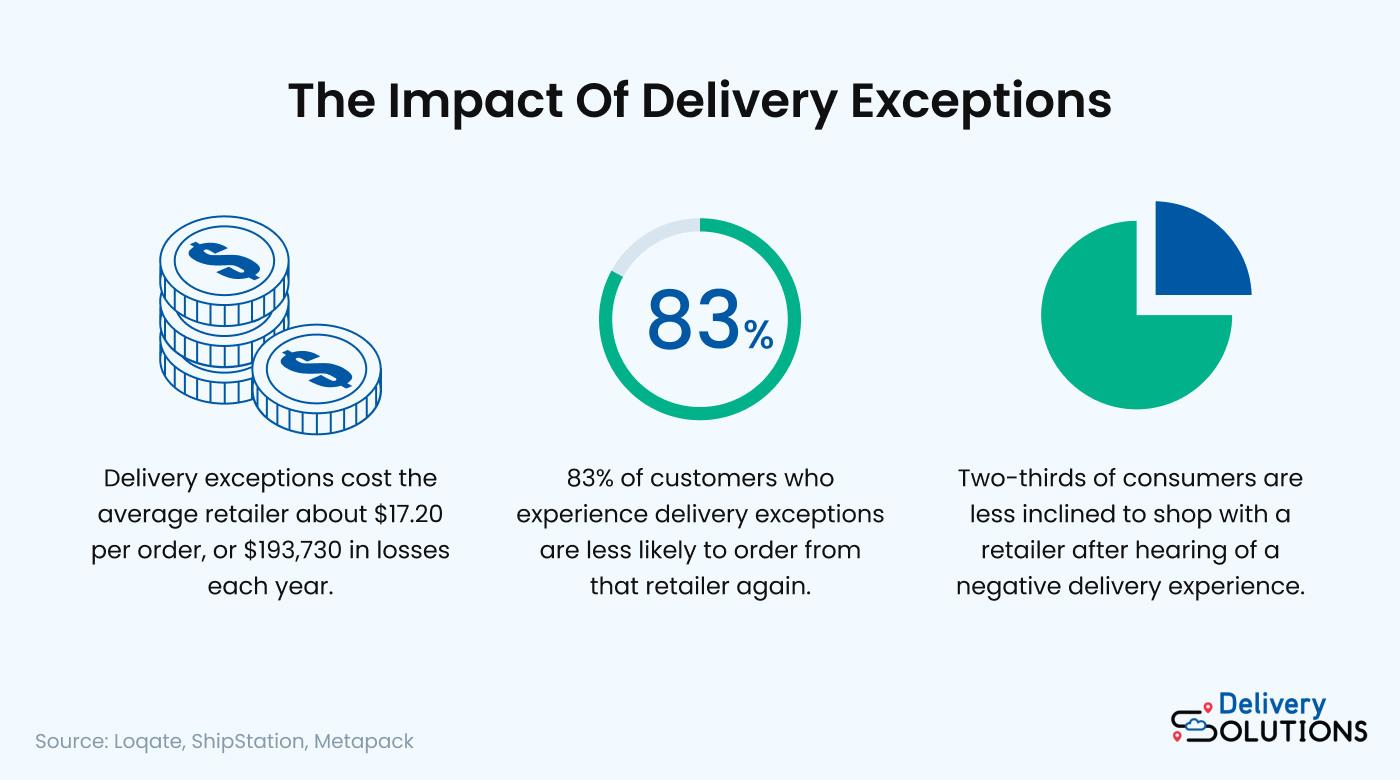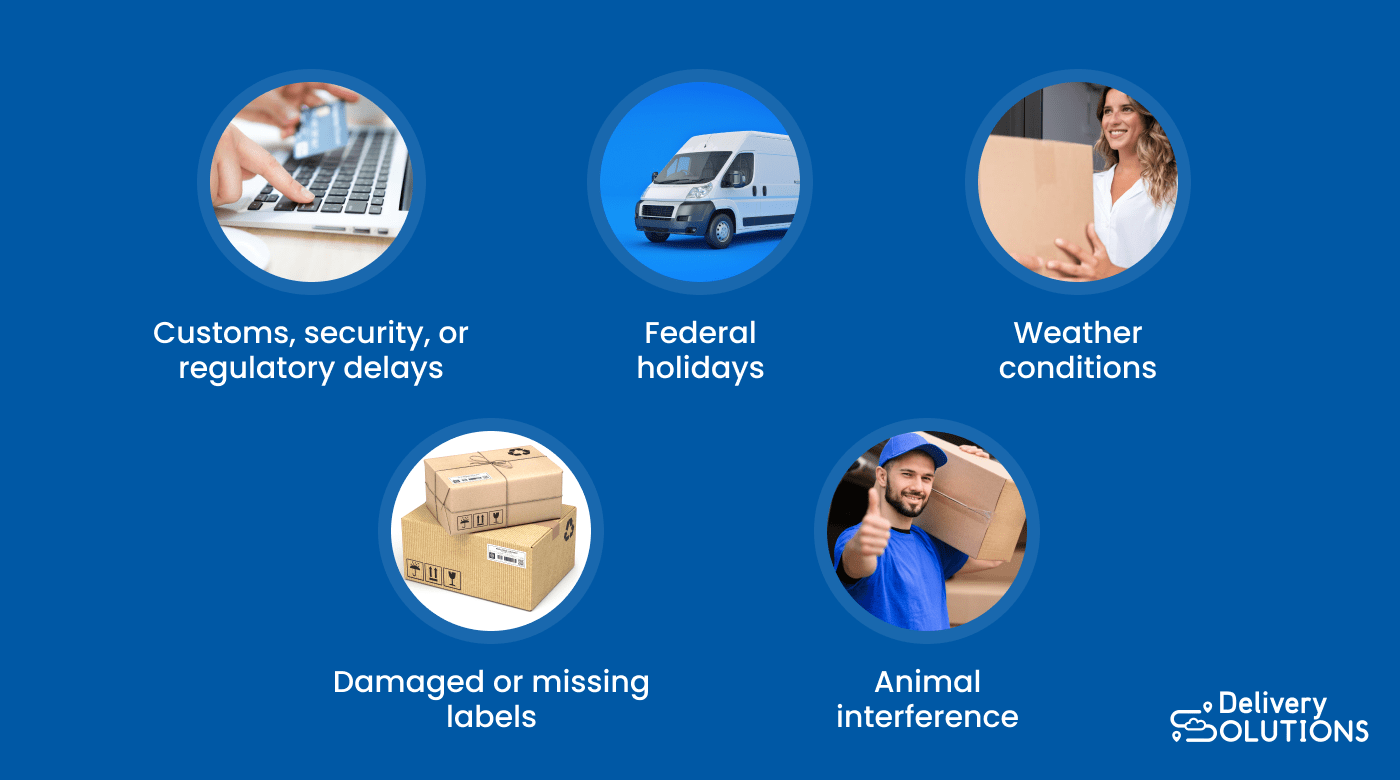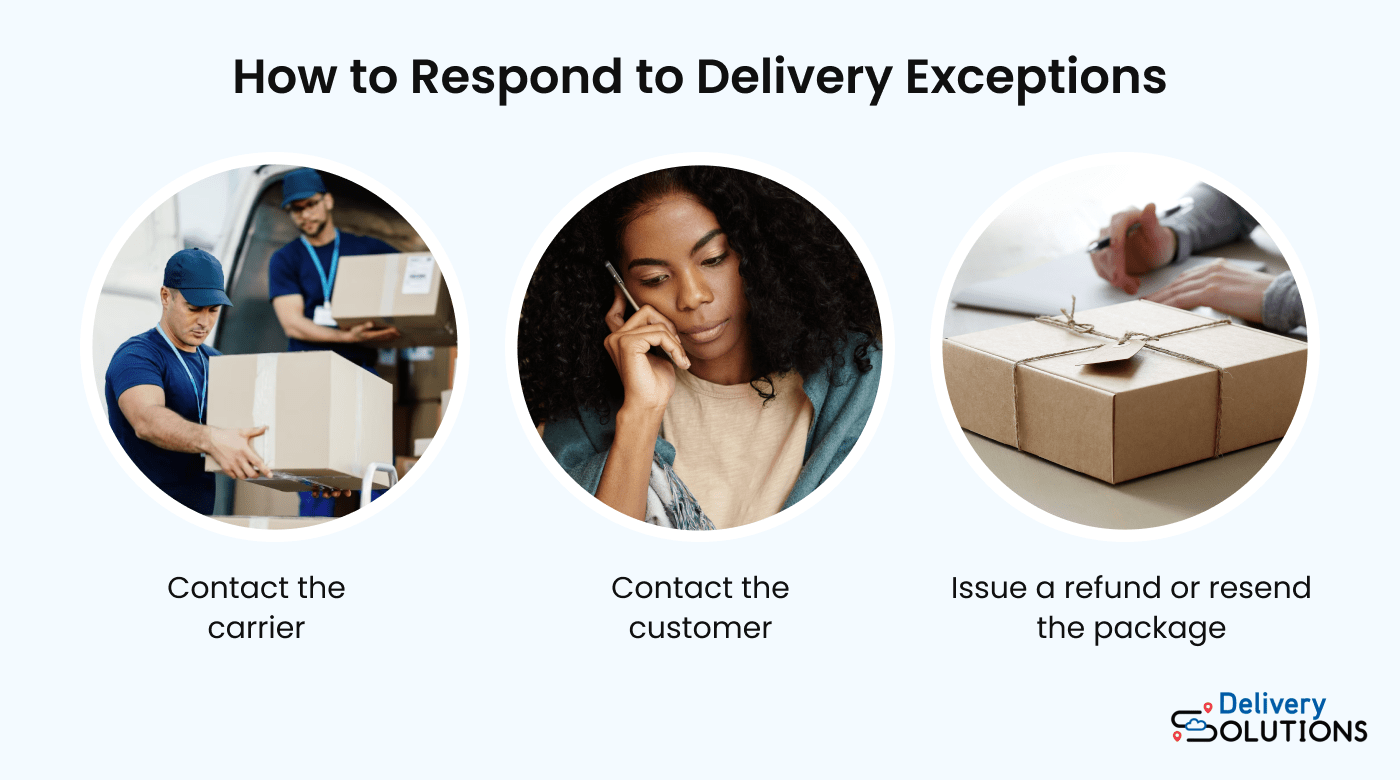As any retailer knows, the importance of the delivery experience cannot be overstated.
Customer expectations are soaring — a staggering 87% of customers consider delivery a key factor when deciding where to shop.
And with deep-pocketed mega-retailers willing and perfectly able to cater to their every whim, ensuring a seamless and reliable delivery process is the least you can do to stay competitive in today’s retail landscape.
If you fail to provide an efficient and dependable delivery experience, customers will take their business elsewhere without so much as a moment’s hesitation.
Moreover, if you operate in global markets, be prepared for an extra layer of complexity, because you’ll have to contend with the fact that 55% of customers have the perception that international orders are more prone to delivery delays.
But it doesn’t end there. You must also partner with reputable and reliable carriers if you want to meet customer expectations, seeing as 70% of consumers firmly believe that the carrier assigned to their order significantly impacts the overall delivery experience.
And what about the consequences of subpar delivery experiences?
To find the answer to that question, look no further than the 35% of consumers who have completely stopped shopping with a retailer following a single negative delivery encounter.
Still, 40.6% of shoppers today frequently face after-purchase problems in one form or the other.

So it’s time to learn what delivery exceptions are and how they impact the delivery experience, customer satisfaction, and brand loyalty. We’ll also look at measures you can take to mitigate their occurrence and ways to lessen their impact when they inevitably occur.
What is a delivery exception?
Delivery exceptions refer to unexpected events that occur during the transportation process and disrupt the normal flow of product shipments. These exceptions can come in a variety of forms ranging from customs issues to unforeseeable transportation hiccups.
11% of all shipments experience delivery exceptions, and 5% never reach their final destination. In an industry notorious for razor-thin margins, this is a worrying statistic for retailers. That’s why it's important to understand how to at least mitigate the effects of delivery exceptions, seeing as they’re inevitable.
It’s worth noting that not all delivery exceptions are negative, though. Sometimes unexpected events, such as early arrival due to improved transit times, can actually improve overall efficiency. Such cases would be considered positive delivery exceptions.
When an unexpected event occurs during the shipping process, the carrier will generate a delivery exception notice and assign it a status code.
The most common of these codes include:
- ‘On-time,’ which denotes deliveries that arrive as scheduled or within the specified tolerance limits
- ‘Delayed,’ which refers to any deliveries that take longer than prescribed to reach their destination
- ‘Exception,’ which is applied when any other type of issue — such as packages with incorrect labels or lost packages — occurs
To avoid costly delays and keep customer satisfaction high, you should take these notifications seriously and swing into action swiftly to resolve these issues as soon as they arise.
Otherwise, you risk incurring the catastrophic ripple effects of delivery exceptions, such as disgruntled customers waiting for late shipments and increased operational expenses.
The impact of delivery exceptions
Delivery exceptions can have a significant impact on both retailers and customers, both financially and otherwise.
For one, they can result in additional costs such as rescheduling delivery or shipping replacement items. These costs alone amount to about $17.20 per order, or about $193,730 per retailer, every year.
Beyond those, they can also result in the loss of customers. 83% of customers who experience delivery exceptions are less likely to order from that retailer again. This is bad news, given that it’s become much more expensive to acquire customers — it now costs up to five times more to acquire a customer than to retain one.
And that’s not all. About 66.67% of consumers are less likely to shop with a retailer if they hear about a negative delivery experience. When you consider that up to 60% of customers have shared a negative delivery experience with people they know, it’s easy to see how problematic this is.
Add to this the social media posts made by 15% of consumers and the online reviews left by 22% of customers after a negative delivery experience and the scale of the problem becomes even more glaring.

Causes of delivery exceptions
Let’s now explore some of the most common causes of delivery exceptions.
Customs, security, or regulatory delays
One of the biggest contributors to delivery exceptions, especially for international shipments, are regulatory, security, or customs delays.
Customs inspections can often take several days depending on the tariff codes associated with the imported products in question. And if you’re shipping items that are subject to extra regulatory scrutiny by the government in that region, your shipment may be flagged during this process, leading to worse delays.
The most effective solution to this problem is to familiarize yourself with the laws, regulations, and tariffs that apply to your products in the jurisdiction to which you’ll be shipping said items. You should also endeavor to have all the documents required to obtain clearance at the borders.
Federal holidays
Another major contributor to stoppages in the shipping process is federal holidays. And since these are inevitable, your best bet is to understand the national holiday calendar and find out the dates of any upcoming federal holidays so that you can plan and account for them when estimating shipping times.
As a corollary to this, you should also consider what days your carrier is closed as part of their standard practice.
Check customers’ delivery addresses and confirm whether they fall within areas affected by federal holidays. If they do, plan accordingly and communicate new delivery times that account for any potential delays to the affected customers.
Proper planning and communication in this way can help smooth deliveries and temper customer expectations on even the busiest of national holidays.
Weather conditions
Inclement weather is another major cause of delivery exceptions. Heavy rain and snowstorms are particularly notorious for forcing delivery processes to their knees and bringing them to a standstill. And despite giant strides in meteorology, weather can be unpredictable.
Adverse weather conditions can have wide-ranging impacts on shipments, from minor delays to outright damage to goods in transit.
So, it’s important to plan and account for potential delays due to these severe weather conditions.

Damaged or missing labels
Shipping labels are critical in the delivery process as delivery operators rely on them to quickly and efficiently identify packages and determine shipping destinations.
So, it goes without saying that damaged, unreadable, or missing labels can cause confusion and delays in the delivery process.
To mitigate such occurrences, you must ensure that all shipping labels are printed correctly with all necessary information before leaving the warehouse.
You should also put processes in place to quickly address any issues that may arise during the transportation process.
Animal interference
Last-mile deliveries are the most susceptible to delivery exceptions caused by animal interference.
There are many ways in which animals may interfere with the delivery process and lead to exceptions. Some of the most common ways are as follows:
- Disrupting transit by blocking roads or railroads
- Damaging packages during transport
- Eating or stealing items from a package
- Causing accidents while driving
One way to mitigate such occurrences is to use more robust packaging solutions that are resistant to animal interference. You can also invest in route optimization technology to minimize time spent in areas that are notorious for animal-related disruptions.

How to respond to delivery exceptions
You now know what delivery exceptions are and their causes. But how do you respond when they inevitably occur? There are three things you must do:
- Contact the carrier
- Contact the customer
- Issue a refund or resend the package

Let’s break down what each of these entails.
1. Contact the carrier
Your first step when dealing with a delivery exception should be to contact the responsible carrier immediately. Think of it like your car breaking down on the highway — you need assistance as soon as possible.
Whether the exception happens because of an incorrect address, wrong tracking status, or delivery guarantees not being met, communication with your carrier is crucial and can help you rectify the problem if something goes wrong with a shipment.
2. Contact the customer
Right after contacting the carrier, your next step should be to contact the customer. You must proactively reach out to the customer before they raise a complaint or risk jeopardizing the trust they have in you.
For this to work optimally, you’ll need well-trained customer service representatives that are knowledgable about the delivery process so that they can provide prompt, accurate, and helpful answers to any questions that customers might have.
3. Issue a refund or resend the package
Finally, you must issue a refund or resend the package as quickly as possible. Depending on the situation, you must decide which is the more appropriate response. And in either scenario, you must send a delivery exception notice to the customer.
A refund will put the customer’s mind at ease and ensure that they don’t have to wait for their item any longer than necessary. But resending the item saves the customer the hassle of having to reorder the item and dealing with any associated additional fees.
Both options are valid ways to deal with exceptions, and the right choice ultimately comes down to which you consider to be more appropriate to the situation, your business, and your customers.
In all, taking these steps will ensure that your relationship with your customers remains strong no matter what, and this will contribute immensely toward creating a positive delivery experience for them, making them more likely to do business with you in the future.
How to minimize the impact of delivery exceptions
There are many ways to minimize the impact of delivery exceptions. Some of them are as follows:
- Use multiple carriers
- Verify all delivery addresses
- Adopt helpful software
- Build an order tracking page

Let’s now discuss each of these methods in greater detail.
1. Use multiple carriers
Leveraging multiple international shipping partners equips you to handle unexpected events, ensuring that customers stay happy and delivery processes remain smooth. By using multiple shipping carriers, you can create a cost-effective omnichannel experience for your customers that’s future-proof.
2. Verify all delivery addresses
For every shipment, you’ll want to ensure that the zip code, country, and other details are correct for the destination. The goal here is to minimize errors when creating optimal delivery routes for shipments and to avoid any issues with border control and customs in the destination country.
Beyond that, verifying shipping information also makes it possible to provide more accurate estimates of arrival times and other important information related to deliveries.
The best way to verify delivery addresses is to use delivery management software. They can verify addresses upfront and in real-time, eliminating the risk of exceptions due to incorrect addresses.
3. Adopt helpful software
Another way to minimize the effects of delivery exceptions is to use software. Specialized software can help keep your customers in the loop and optimize your delivery operations.
Additionally, they can provide actionable insights into the performance of your deliveries, equipping you to make data-driven decisions on how to improve them going forward.
Take DeliverySolutions for example. The “Self Healing” feature on our platform manages the DSPs for you and can mitigate any logistics issues.
For instance, if a driver has an issue and can’t complete a delivery, our system will automatically queue up another driver from the list of available DSPs to continue the delivery. The end result: nothing changes from the end customer’s perspective.
4. Build a tracking page
Creating an order tracking page can also help reduce the impact of delivery exceptions by allowing customers to see the status of their orders in real-time. This enhances the delivery experience and eliminates the need to contact you to find out this information. And naturally, this leads to cost savings and increased operational efficiency for you.
Conclusion
The challenges posed by delivery exceptions to businesses are clear, and now you know not just why it’s important to address them, but also how to mitigate the effects.
Yet it doesn't have to be difficult. With Delivery Solutions' Platform, you can take control of your entire delivery experience and make sure that exceptions never become a major issue.
Russ Bair
Russ Bair is the Chief Product Officer at Delivery Solutions, the leading provider of last-mile delivery and fulfillment software. He helps ensure retailers achieve their goals and they are able to provide meaningful experiences for their customers. Prior to his tenure at Delivery Solutions, Russ was President of projekt202—an experience-driven consulting firm founded to apply deep ethnographic research to the development of mobile, web, and workplace software. He received his Bachelors in Computer Science from Texas A&M and has more than 25 years of extensive experience in the software development and consulting fields. While holding leadership roles within organizations or various sizes, Russ has designed, developed, and led the creation of complex custom software implementations for small, medium, and Fortune 500 companies across the United States. Russ is fulfilled by helping those around him reach their potential through servant leadership and collaborating to create progress and economic value. He currently lives in the Dallas area with his wife Jana and two children.
Topics from this blog: Delivery Improvement Efficiency
